
http://www.iaeme.com/IJM/index.asp 89 editor@iaeme.com
International Journal of Management (IJM)
Volume 8, Issue 6, Nov–Dec 2017, pp. 89–98, Article ID: IJM_08_06_011
Available online at
http://www.iaeme.com/ijm/issues.asp?JType=IJM&VType=8&IType=6
Journal Impact Factor (2016): 8.1920 (Calculated by GISI) www.jifactor.com
ISSN Print: 0976-6502 and ISSN Online: 0976-6510
© IAEME Publication
JOB SATISFACTION AND JOB COMMITMENT
AMONG EMPLOYEES WORKING IN
SELECTED PUBLIC SECTOR BANKS IN
COIMBATORE
N.R. Shandy
Research Scholar, PSGR Krishnammal College for Women,
Coimbatore, Tamilnadu, India
ABSTRACT
The term 'job satisfaction' came in vogue in 1935 with the publishing of a book
"job satisfaction" by hoppock1. he was the first industrial psychologist to provide the
concept of job satisfaction. Meyer and Allen (1991) describe behavioral commitment
as a form of commitment that is very elusive and beyond conscious recognition. It
relates to the process of becoming locked into an organization and how employees
deal with this. The unique aspect of this study is that the researcher made an attempt
to identify what are the factor leading to job dissatisfaction and also whether there is
lack of affective commitment, continuance commitment and normative commitment
that can influence in their job of employees working in select public sector banks in
Coimbatore. Opinion survey method was used to collect data from 122 respondents.
Stratified random sampling technique was used. Relevant statistical techniques like
percentage analysis and weighted mean are used for the study. It is observed from the
study that majority of the employees working in select public sector banks were found
to be happy and satisfied with their job which also can influence their commitment
level in their institutional settings.
Key words: Job satisfaction, affective commitment, continuance commitment
normative commitment.
Cite this Article: N.R. Shandy, Job Satisfaction and Job Commitment among
Employees Working in Selected Public Sector Banks in Coimbatore. International
Journal of Management, 8 (6), 2017, pp. 89–98.
http://www.iaeme.com/IJM/issues.asp?JType=IJM&VType=8&IType=6
1. INTRODUCTION: JOB SATISFACTION AND JOB COMMITMENT
Job Satisfaction expresses the amount of agreement between one's expectations of the job and
the rewards that the job provides. The term 'Job Satisfaction' came in vogue in 1935 with the
publishing of a book "Job Satisfaction" by Hoppock1. He defined it as "any combination of
psychological, physiological and environmental circumstances that cause a person truthfully
to say I am satisfied with the job." Misra and Srivastava2 opines that, "Job satisfaction or

N.R. Shandy
http://www.iaeme.com/IJM/index.asp 90 editor@iaeme.com
dissatisfaction is the result of various factors which are related to present job situations. These
various factors are opportunities for career advancement, amount of tension at work, work
involvement, relations with colleagues and supervisors, due recognition of merit, sufficient
emoluments and good working conditions, grievances removal, feeling of fatigue and
loneliness and prestige of the organization‖. Meyer and Allen‘s model assumed organizational
commitment encompassed three conceptually and empirically distinct dimensions, labeled
affective, continuance, and normative commitment. (Meyer, John P, Natalie J, & Allen,
1991)3. The differences between these dimensions (or components) were relatively
straightforward, holding ―employees with a strong affective commitment remain with [an]
organization because they want to, those with a strong continuance commitment remain
because they need to, and those with a strong normative commitment remain because they
feel they ought to do so‖ (Meyer et al. 1993, p. 539)4.
2. OVERVIEW OF BANKING SECTOR
The tremendous growth in the banking sector during the last six and half decades is
appreciable. The number of commercial bank branches has increased from less than 100 in
1947 to around 8,000 in 1969 to 87,152. The average population per bank credit delivery
outlet works out to around 5,000. Thus, there is a banking outfit (commercial or co-operative)
for about every 5,000 persons in India. Scheduled Commercial Banks in India are categorized
in five different groups according to their ownership and/or nature of operation. These bank
groups are (i) State Bank of India and its associates, (ii) Nationalised Banks, (iii) Regional
Rural Banks, (iv) Foreign Banks and (v) Other Indian Scheduled Commercial Banks (in the
private sector). All Scheduled Banks comprise Schedule Commercial and Scheduled Co-
operative Banks. Scheduled Cooperative banks consist of Scheduled State Co-operative
Banks and Scheduled Urban Cooperative Banks. Public Sector Banks (PSBs) are banks
where a majority stake (i.e. more than 50%) is held by a government. The shares of these
banks are listed on stock exchanges.
3. LITERATURE REVIEW
Saari and Judge (2004) in their study entitled ―Employee Attitudes and Job Satisfaction‖
identified three major gaps between HR practice and the scientific research in the area of
employee attitudes in general and the most focal employee attitude in particular—job
satisfaction: (1) the causes of employee attitudes, (2) the results of positive or negative job
satisfaction, and (3) how to measure and influence employee attitudes. Suggestions for
practitioners are provided on how to close the gaps in knowledge and for evaluating
implemented practices.
Anu Singh Lather et al. (2005) in their study entitled ―Motivation and Job Satisfaction, A
Study of Associates of Public and Private Sector Institutions‖ founded a significant positive
correlation between the job satisfaction and need for autonomy and self actualization of top
level managers. The significant positive correlation was found between the job satisfaction
and need for self-control, monetary gains and social affiliation and conformity of middle level
managers. Significant negative correlation was found between job satisfaction and need for
non financial gains of middle level managers. There was a significant positive correlation
between job satisfaction and need for self control of supervisors and significant positive
correlation between job satisfaction and need for self control and personal growth in workers.
Regression was applied to find the effect of various needs on job satisfaction at different
levels. The results show that need for autonomy and self actualization is a significant positive
predictor of job satisfaction for top level managers.

Job Satisfaction and Job Commitment among Employees Working in Selected Public Sector
Banks in Coimbatore
http://www.iaeme.com/IJM/index.asp 91 editor@iaeme.com
Rothner et al. (2005) in their study entitled ―Psychological Well-being and Job
Satisfaction of Employees in a Financial Institution‖ determine the relationship between
psychological wellbeing (i.e. self-efficacy, positive and negative effect, and sense of
coherence) and job satisfaction of employees in a financial institution. An availability sample
(N = 117) was taken from employees from different levels in a financial institution. The
results showed acceptable internal consistencies for all the constructs. Product-moment
correlation coefficients showed significant positive correlations between self-efficacy,
positive effect, sense of coherence and job satisfaction and significantly negative correlations
between negative effect, self-efficacy, positive affect and sense of coherence.
Best (1994) indicates that organisational commitment as a behaviour is evident when
―committed individuals enact specific behaviours due to the belief that it is [sic] morally
correct rather than personally beneficial‖.
Reichers (1985: 468) is of the opinion that ―organisational commitment as behaviour is
visible when organisational members are committed to existing groups within the
organisation‖. Therefore, organisational commitment is a state of being in which
organisational members are bound by their actions and beliefs that sustain their activities and
their own involvement in the organisation
Indridason, T. and Wang, C. L., (2008) observed that if employees are made part of the
organizational decision making process, their commitment levels would increase. Moreover,
commitment has been proved to be an effective predictor of job performance and citizenship
behavior. Creating organizational commitment involves interaction, educational awareness,
and cooperation-raising programs for the people and rewarding system in the organizations
3.1. Statement of the problem
Many researchers have conducted the study to examine the Job satisfaction leading to
organizational commitment in various sectors, however, the researcher made a novel attempt
considering select public sector bank employees to understand the factual. The unique aspect
of this study is that the researcher made an attempt to identify what are the factor leading to
job dissatisfaction and also whether there is lack of Affective commitment, Continuance
commitment and Normative commitment that can influence in their job of employees working
in select public sector banks in Coimbatore. Opinion survey method was used to collect data
from 122 respondents working in the select public sector banks to identify the problems and
suggest measures for the management to satisfy the employees and also to improve their job
commitment.
3.2. Objectives of the study
To study the job satisfaction among employees working in select public sector banks in
Coimbatore.
To find out the organizational commitment among employees of the select banks.
To contribute suggestions for policy implications.
4. METHODOLOGY
The methodology of this study includes the description of research design, sample size,
sampling technique, development and description of tool, data collection procedure and
method of analysis. The study is descriptive in nature and depends upon primary data.
Questionnaire was prepared for the collection of primary data. Data was collected from both
Primary and Secondary sources. The objective of the study has been accomplished with the

N.R. Shandy
http://www.iaeme.com/IJM/index.asp 92 editor@iaeme.com
help of primary data collected from 122 employees working in select public sector banks
through a structured questionnaire. Secondary data was collected from previous researches,
official statistics, articles in journals, web information etc. Stratified Random Sampling
Technique was used. Relevant statistical techniques like Percentage analysis and Weighted
Mean are used for the study.
5. LIMITATIONS OF THE STUDY
The present study was limited up to 8 public sector banks, hence it lacks universal
applicability. Some respondents were hesitant to answer the questions hence, there may be
some chances of bias.
6. DATA ANALYSIS AND RESULTS
Percentage analysis was used to compute the opinion on demographic variables. Furather
descriptive statistics with Weighted Average and Rank was used to measure the dimensions
viz. Job Satisfaction and Job Commitment (Affective, Continuance and Normative).
6.1. Demographic Variables
The study is conducted to analyze the Job Satisfaction and Job Commitment among
Employees working in select Public Sector Banks in Coimbatore District. Demographic
variables of the employees‘ are such as age, gender, marital status, educational qualification,
designation, experience and monthly income are prepared and presented hereunder.
Table 1 Demographic Variables of the Employees working in Select Public Sector Bank
Sl.
No.
Demographic Variables
Respondents
(122 Nos.)
Percentage
(100%)
1.
Age
Below 30 years
35
28.7
31 to 40 years
51
41.8
Above 40 years
36
29.5
2.
Gender
Male
96
78.7
Female
26
21.3
3.
Marital Status
Unmarried
58
47.5
Married
64
52.5
4.
Educational
Qualification
Graduates (UG/PG)
79
64.8
Professional / Semi-Professional
23
18.9
Others (M.Phil., Ph.D., etc.)
20
16.4
5.
Designation
Assistant Manager
27
22.1
Officer
65
53.3
Clerical / Sub-Staff
30
24.6
6.
Experience
Less than 5 years
41
33.6
5 to 10 years
69
56.6
More than 10 years
12
9.8
7.
Monthly Income
Less than Rs.30,000
43
35.2
Rs.30,001 to Rs.40,000
55
45.1
More than Rs.40,000
24
19.7
Source: Computed from Primary Data
It is clear that maximum (41.8%) of the employees working in select public sector banks
are in the age group of 31 to 40 years, 29.5% of the respondents are in the age above 40 years
and the remaining 28.7% of the employees are in the age below 30 years. It is clear that
majority (78.7%) of the employees are male and 21.3% of the employees are female. It is
evident that marginally more than half (52.5%) of the employees are married and little less
than half (47.5%) of them are unmarried. It is clear that most (64.8%) of the employees are

Job Satisfaction and Job Commitment among Employees Working in Selected Public Sector
Banks in Coimbatore
http://www.iaeme.com/IJM/index.asp 93 editor@iaeme.com
graduates (UG / PG), while 18.9% of the employees are professionals / semi-professionals
(CA, CWA, ACS, etc.) and the remaining 16.4% of them have other qualifications such as
M.Phil. Ph.D., etc. It is clear that more than half (53.3%) of the employees are engaged as
officers in the select public sector banks, 24.6% are working in clerical cadre / sub-staff cadre
and the remaining 22.1% of the respondents are working as Assistant Managers. It is
understood that more than half (56.6%) of the respondents are having 5 to 10 years
experience, while 33.6% of the employees are having experience less than 5 years and the
remaining 9.8% of the employees are having more than 10 years experience. It is clear that
less than half (45.1%) of the employees are drawing income between Rs.30,001 and
Rs.40,000, 35.2% of the employees are having income less than Rs.30,000 and the remaining
19.7% of the employees are having income more than Rs.40,000.
6.2. Job Satisfaction: Descriptive Statistics
Table 2 Opinion on Job Satisfaction of the Employees working in select Public Sector Banks
Opinion
Highly
Dissatisfied
Dissatisfied
Neutral
Satisfied
Highly
Satisfied
Wtd.
Mean
Rank
The working
conditions
12
36
15
37
19
3.049
5
0.098
0.590
0.369
1.213
0.779
My pay and the
amount of work I do
11
26
34
42
6
2.975
6
0.090
0.426
0.836
1.377
0.246
The way my boss
Handles his/her
workers
0
0
14
51
54
4.230
1
0.000
0.000
0.344
1.672
2.213
The Competence of
my supervisor in
making decisions
13
38
35
23
10
2.754
9
0.107
0.623
0.861
0.754
0.410
The way my job
provides for steady
employment
5
18
27
49
20
3.426
3
0.041
0.295
0.664
1.607
0.820
The chances for
advancement on this
job
11
27
40
30
11
2.951
7
0.090
0.443
0.984
0.984
0.451
The way company
policies are put into
practice
6
19
30
42
22
3.377
4
0.049
0.311
0.738
1.377
0.902
The way my coworker
get along with each
other
2
16
28
49
24
3.557
2
0.016
0.262
0.689
1.607
0.984
The feeling of
accomplishment I get
from the job
7
41
31
31
9
2.877
8
0.057
0.672
0.762
1.016
0.369
Source: Computed from Primary Data
It is observed from the Table that rating of the employees working in select public sector
banks was high with respect to the statement ―The way my boss Handles his/her workers‖
with the mean of 4.230, followed by the statements based on the ranks highest to the least viz.
―The way my coworker get along with each other‖, ―The way my job provides for steady
employment‖, ―The way company policies are put into practice‖, ―The working conditions‖,
―My pay and the amount of work I do‖, ―The chances for advancement on this job‖, The
feeling of accomplishment I get from the job‖ and finally, ―The Competence of my supervisor
in making decisions‖ with the mean scores of 3.557, 3.426, 3.377, 3.049, 2.975, 2.951, 2.877
and 2.754 respectively.



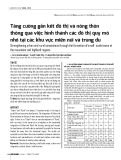
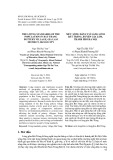



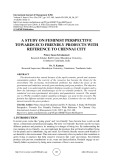
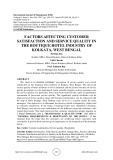
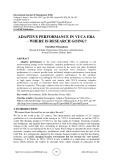
![Bài giảng Công tác xã hội: Khái niệm, phân biệt, quan hệ và chức năng [Chuẩn Nhất]](https://cdn.tailieu.vn/images/document/thumbnail/2025/20251002/littlehippy91/135x160/63461759457333.jpg)
![Tài liệu học tập Nhập môn Công tác xã hội [mới nhất]](https://cdn.tailieu.vn/images/document/thumbnail/2025/20251002/littlehippy91/135x160/50611759457334.jpg)
![Nội dung ôn thi Xã hội học đại cương [chuẩn nhất]](https://cdn.tailieu.vn/images/document/thumbnail/2025/20250930/kisu6910@gmail.com/135x160/12931759283279.jpg)












